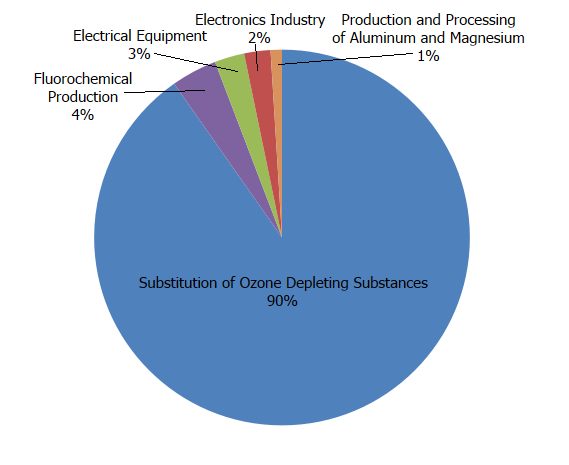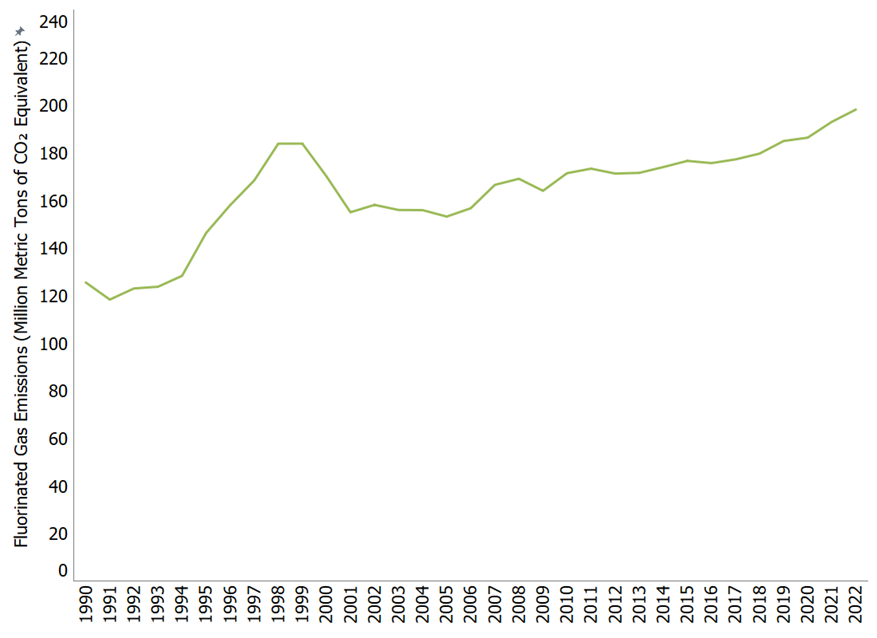Fluorinated Gas Emissions
Chemical Formulas:
HFCs, PFCs, NF3, SF6
Lifetime in Atmosphere:
HFCs: up to 270 years
PFCs: 2,600–50,000 years
NF3: 740 years
SF6: 3,200 years
Global Warming Potential (100-year):1
HFCs: up to 12,400
PFCs: up to 11,100
NF3: 16,100
SF6: 23,500
On this page:
- Sources of Fluorinated Gas Emissions
- Fluorinated Gas Emission Trends
- Reducing Fluorinated Gas Emissions
Sources of Fluorinated Gas Emissions
Unlike many other greenhouse gases, fluorinated gases have no significant natural sources and come almost entirely from human-related activities. They are emitted through their use as substitutes for ozone-depleting substances (e.g., as refrigerants) and through a variety of industrial processes such as aluminum and semiconductor manufacturing.
Many fluorinated gases have very high global warming potentials (GWPs) relative to other greenhouse gases, so small atmospheric concentrations can nevertheless have large effects on global temperatures. They can also have long atmospheric lifetimes—in some cases, lasting thousands of years. Like other long-lived greenhouse gases, most fluorinated gases are well-mixed in the atmosphere, spreading around the world after they are emitted. Many fluorinated gases are removed from the atmosphere only when they are destroyed by sunlight in the upper atmosphere. In general, fluorinated gases are the most potent and longest lasting type of greenhouse gases emitted by human activities.
There are four main categories of fluorinated gases—hydrofluorocarbons (HFCs), perfluorocarbons (PFCs), sulfur hexafluoride (SF6), and nitrogen trifluoride (NF3). The largest sources of fluorinated gas emissions are described below.
- Substitution for Ozone-Depleting Substances. Hydrofluorocarbons are used as refrigerants, aerosol propellants, foam blowing agents, solvents, and fire retardants in products used by homes, businesses and industry. The major emissions source of these compounds is their use as refrigerants—for example, in air conditioning systems in both vehicles and buildings. These chemicals were developed as a replacement for chlorofluorocarbons (CFCs) and hydrochlorofluorocarbons (HCFCs) because they do not deplete the stratospheric ozone layer. CFCs and HCFCs are also greenhouse gases; however, their contribution is not included here because they are being phased out under an international agreement called the Montreal Protocol. HFCs are potent greenhouse gases with high GWPs, and they are released into the atmosphere during manufacturing processes and through leaks, servicing, and disposal of equipment in which they are used. Newly developed hydrofluoroolefins (HFOs) are a subset of HFCs and are characterized by short atmospheric lifetimes and lower GWPs. HFOs are currently being introduced as refrigerants, aerosol propellants and foam blowing agents. The American Innovation and Manufacturing (AIM) Act of 2020 directs EPA to address HFCs by providing new authorities in three main areas: to phase down the production and consumption of listed HFCs in the United States by 85% over the next 15 years, manage these HFCs and their substitutes, and facilitate the transition to next-generation technologies that do not rely on HFCs.
- Industry. Perfluorocarbons are produced as a byproduct of aluminum production and are used in the manufacturing of semiconductors. PFCs generally have long atmospheric lifetimes and GWPs near 10,000. Sulfur hexafluoride is used in magnesium processing and semiconductor manufacturing, as well as a tracer gas for leak detection. Nitrogen trifluoride is used in semiconductor manufacturing. HFC-23 is produced as a byproduct of HCFC-22 production and is used in semiconductor manufacturing.
- Transmission and Distribution of Electricity. Sulfur hexafluoride is used as an insulating gas in electrical transmission equipment, including circuit breakers. The GWP of SF6 is 23,500 making it the most potent greenhouse gas that the Intergovernmental Panel on Climate Change has evaluated.
EPA collects data from significant fluorinated gas producers and consumers through the Greenhouse Gas Reporting Program. To find out more about the role of fluorinated gases in warming the atmosphere and their sources, visit the Fluorinated Greenhouse Gas Emissions page.
Fluorinated Gas Emission Trends
Overall, fluorinated gas emissions in the United States have increased by 105% between 1990 and 2022. This increase has been driven by a 349% increase in emissions of hydrofluorocarbons (HFCs) since 1990, as they have been widely used as a substitute for ozone-depleting substances. Emissions of perfluorocarbons (PFCs) and sulfur hexafluoride (SF6) have declined during this time due to emission-reduction efforts in the aluminum production industry (PFCs) and the electrical transmission and distribution industry (SF6).
Reducing Fluorinated Gas Emissions
Because most fluorinated gases have a very long atmospheric lifetime, it will take many years to see a noticeable decline in current concentrations. There are, however, a number of ways to reduce emissions of fluorinated gases, described below.
| Emissions Source | Examples of How Emissions Can be Reduced |
|---|---|
| Substitution of Ozone-Depleting Substances in Homes and Businesses |
Refrigerants used by businesses and residences emit fluorinated gases. Emissions can be reduced by better handling of these gases and use of substitutes with lower global warming potentials and other technological improvements. Visit EPA's Ozone Layer Protection site and HFC Phasedown site to learn more about reduction opportunities in this sector. |
| Industry |
Industrial emitters of fluorinated gases can reduce emissions by adopting fluorinated gas capture and destruction processes, optimizing production to minimize emissions, and replacing these gases with alternatives. EPA has experience with these gases in the following sectors: |
| Electricity Transmission and Distribution |
Sulfur hexafluoride is an extremely potent greenhouse gas that is used for several purposes when transmitting electricity through the power grid. EPA is working with industry to reduce emissions through the SF6 Emission Reduction Partnership for Electric Power Systems, which promotes leak detection and repair, use of recycling equipment, and consideration of alternative technologies that do not use SF6. |
| Transportation |
Hydrofluorocarbons (HFCs) are released through the leakage of refrigerants used in vehicle air-conditioning systems. Leakage can be reduced through better system components and through the use of alternative refrigerants with lower global warming potentials than those presently used. EPA’s light-duty and heavy-duty vehicle standards provided incentives for manufacturers to produce vehicles with lower HFC emissions. |
References
1IPCC (2013) Climate Change 2013: The Physical Science Basis. Contribution of Working Group I to the Fifth Assessment Report of the Intergovernmental Panel on Climate Change. [Stocker, T.F., D. Qin, G.K. Plattner, M. Tignor, S.K. Allen, J. Boschung, A. Nauels, Y. Xia, V. Bex and P.M. Midgley (eds.)]. Cambridge University Press, Cambridge, United Kingdom and New York, NY, USA, 1535 pp.


